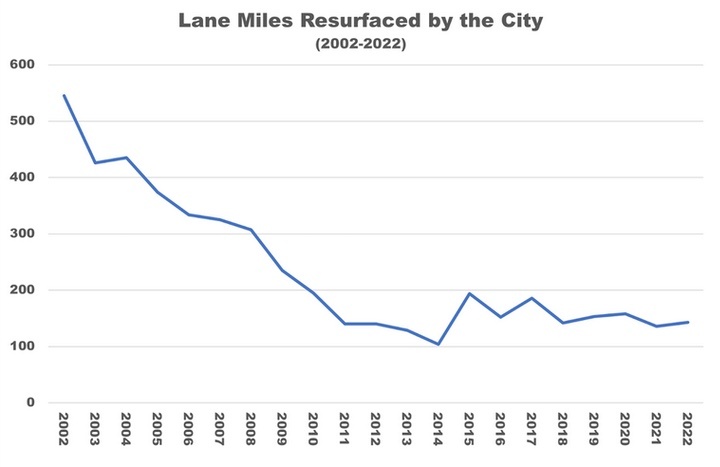This op-ed by Charles Marohn appeared on StrongTowns,org on April 1, 2024. We are sharing it in two parts.
It’s generally believed that Detroit went bankrupt because people fled Detroit, leaving too much city to be sustained by too few people. That’s overly simplistic, but not completely wrong. If we run with it for a moment, we’ll find that Detroit has a population of 630,000 spread out over 143 square miles. That’s 4,400 people per square mile. In comparison, Houston has 2.3 million people in 671 square miles, or 3,400 people per square mile. If Detroit’s math doesn’t work — and it doesn’t — note that it has 30% more people per square mile to shoulder the financial burden of servicing and maintaining all that they have built than Houston has.
Go back to the analogy with my daughter and college. What would the fourth option look like for a city? What does it look like to walk away from a promise?
Last year, the Bill King Blog looked at Houston and why their streets are in such bad condition. The conclusion: a lack of investment. Now, the blog might have some odd reasons as to why that investment hasn’t happened, but focus on the trend. This is what it looks like when a budget gets squeezed, when debt service (aka: buying time via debt) stacks up, along with other unignorable promises like pensions and firefighter settlements. These things squeeze the budget and since streets fall apart slowly they become the thing that can be short changed without immediate pain.

The blog quotes the City’s Public Works Director back in 2016 conceding “that the City has only been doing 25-30% of the repaving necessary, but confidently predicted ‘being able to double the amount of work we do in five to eight years.’” That was naively optimistic. In reality, Houston is doing less street maintenance today than when the director made that prediction almost eight years ago.
So, Houston is financially screwed. Absolutely screwed. But remember, they are the cleanest shirt in a stack of dirty laundry. If you are reading this and you live in a U.S. or Canadian city, your municipal corporation is almost certainly in worse shape. What do we do about it?
What can we do now?
We spend every day working on that answer here at Strong Towns, but let me share an insight from another mayor, this one the former mayor of Seattle, now the Executive Director of America Walks (an organization that is definitely part of the answer). Here was his response to Houston’s financial shortfall.

Mayor McGinn has been through this himself. His city had a chance to spend less money on a project to convert the Alaska Way Viaduct from an elevated highway to a connected boulevard, redirecting billions of dollars of public funding from highway construction into transit and walking/biking infrastructure. The move would have saved billions and induced many multiples of that in private investment, making Seattle simultaneously wealthier and a better place to live. He ran on that platform, won a mandate, and then faced the unstoppable wave of state and federal transportation funding.
McGinn lost. Seattle lost. Ten billion dollars later, traffic in the new tunnel is down 23% and the city is still paying for unanticipated cost overruns.
Here’s my response to McGinn.

The federal government is more interested in next quarter’s economic statistics than they are in the long-term health of your city. Ditto with the state government. That is not an anti-government statement; it’s an observation of what their financial incentives are (follow the money). The state and federal government mostly tax transactions and so an economy that generates a lot of transactions is going to make their life easier.
Cities don’t work this way. Cities need to build wealth in their neighborhoods in order to sustain themselves. A local government can’t spend a dollar providing street access to a property where they only get 20 cents in return. Well, they can do it, but it will catch up to them eventually.
Here’s the key: state and federal governments will pay cities all day and every day to make bad financial decisions and transactions that are not in the broad financial interest of their own residents. They have lots of programs to do this, highway expansions being just one of them. It’s not that state and federal officials are evil; they are just not sensitive to the financial ramifications of these transactions. And to be fair, cities are generally insensitive to them as well (even though they bear the long-term burden).
Fundamentally, that is what needs to change. As local leaders, we need to become more sensitive, more aware, of the financial implications of our development pattern. Here’s the good news: we can easily do that. We don’t have to ignore the long-term liabilities. We don’t have to do projects that make us poorer. We’re not powerless.
You are not powerless.
Strong Towns is a movement to make our cities financially strong and resilient. We have developed an entire set of responses to this challenge, with more coming all the time. If you’re just finding us, it’s not too late to get started.

